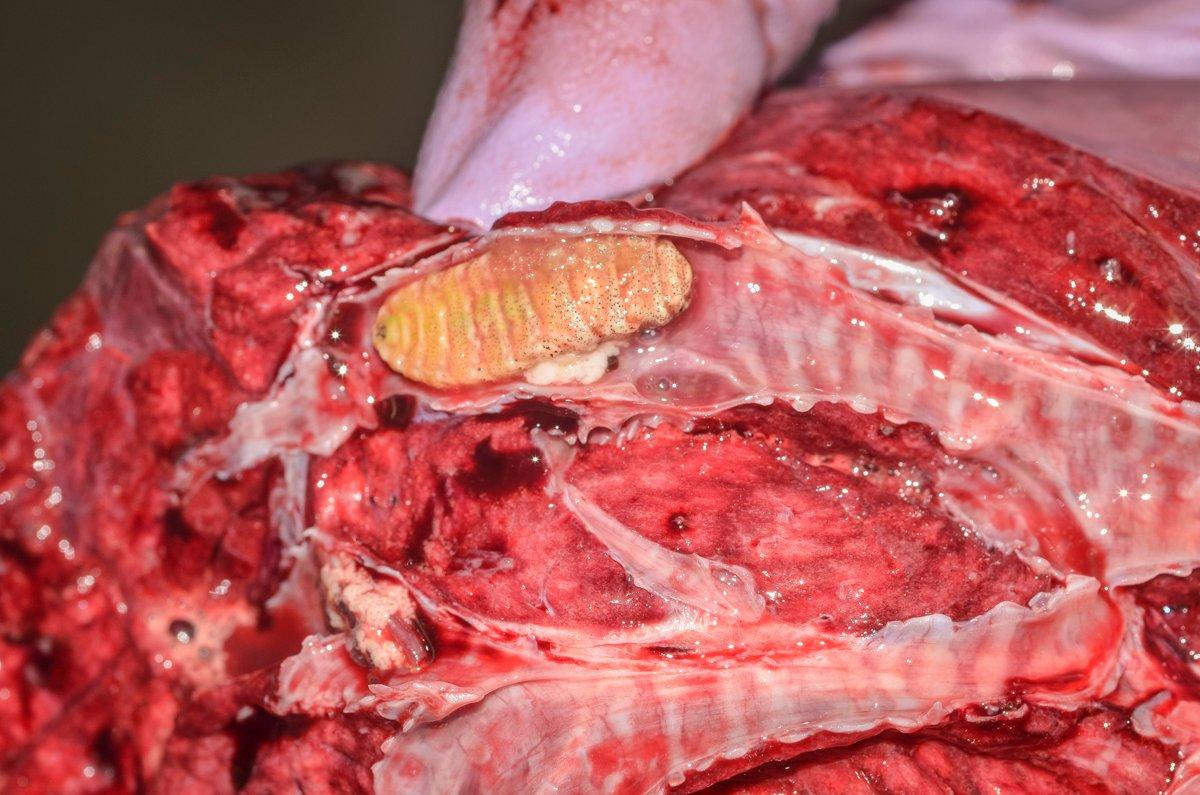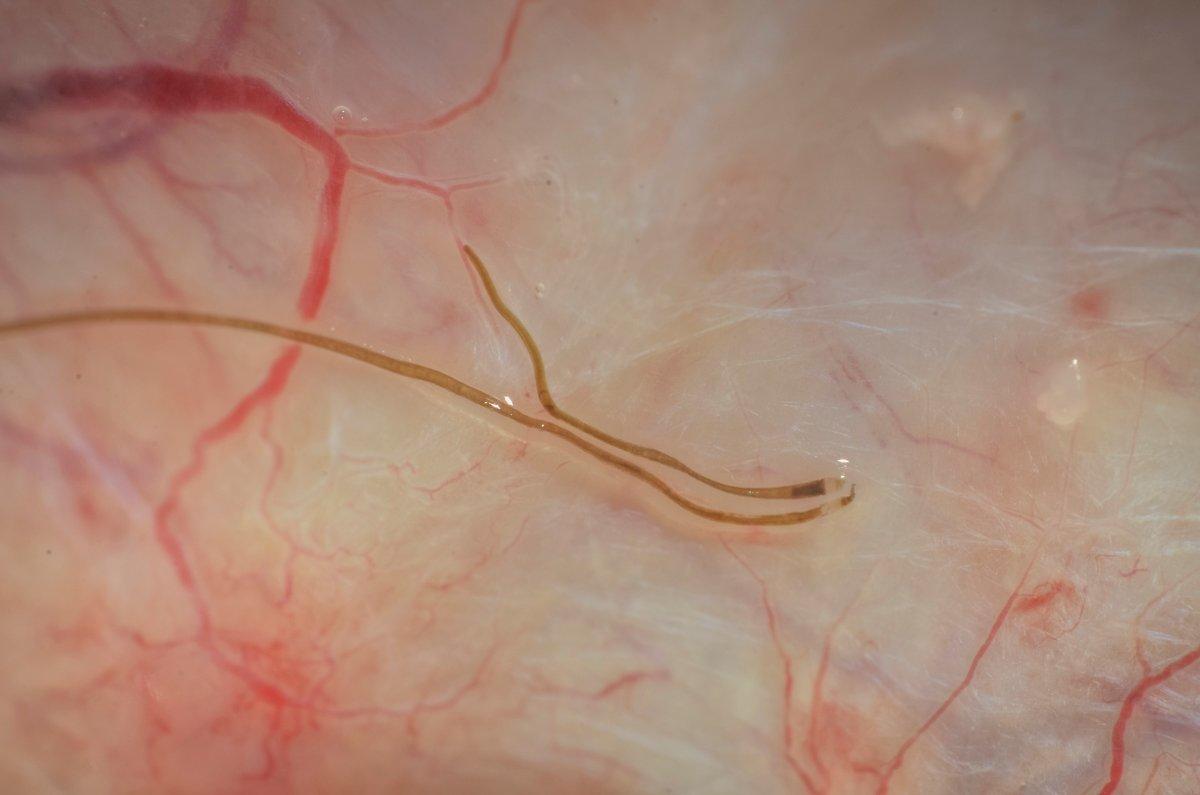Most deer parasites are harmless to hunters — but a few are dangerous. From ticks to liver flukes, here's what to know
Deer are covered in parasites, inside and out. In fact, a Southeastern Cooperative Wildlife Disease Study done on free-ranging whitetail deer in Natchez, Mississippi, found an average of 3,988 various parasites per deer. Are they dangerous to hunters who handle and eat the deer they kill? Luckily, in the vast majority of instances, the answer is no. Still, as an avid deer hunter — and an even more avid deer eater — I like to know exactly what's living in and on my venison.
Common deer parasites are either internal, which live in the deer's intestinal, muscular, and respiratory systems, or external, which live in or on the skin.
Ready to be disgusted? Read on.
External Parasites
Ticks
Of all the parasites listed, ticks pose the most risk to hunters. Tick-borne diseases are becoming ever more common in the United States, with the worst offenders being Lyme disease, Rocky Mountain tick fever, tularemia, anaplasmosis and alpha-gal allergy. Whitetails carry an abundance of ticks and tick species, many of which carry diseases transferable to humans.
Common tick species on whitetails include blacklegged ticks (also known as deer ticks), Lone Star ticks, American and brown dog ticks, and Rocky Mountain woods ticks. Unfortunately for hunters, ticks tend to detach from their hosts soon after the deer dies, and that's when they most often transfer to human hosts. Care should be taken to limit direct contact with the body of the deer when moving, photographing and skinning. After handling your downed deer, inspect your clothing and body for any ticks that may have hitched a ride.
Besides the human health risks, serious tick infestations can cause hair loss, anemia, and high fawn mortality rates in deer.
Deer Ked
Other external parasites common on whitetails include deer ked, a wingless fly that grows to about 1/8 inch as an adult and lives on a deer's skin for up to six months, feeding on its blood as it grows to adulthood. Like severe tick infestations, deer ked infestations can cause enough blood loss to cause health issues, especially during hard winters.
Additional Biters
Other external parasites are less impactful on deer health and pose no risk to hunters. These include mites, lice and Psoroptic mange. These common parasites often live year-round on the deer's skin and cause mostly minor skin irritation.
Extreme cases of mites can cause patchy hair loss in whitetail deer. Occasionally, mites infect the ear canals of deer, sometimes leading to secondary infections and hearing damage.
Don't Miss: Alpha-Gal Syndrome is a Deer Hunter's Nightmare
Internal Parasites
Internal parasites can live throughout the deer's body in the bloodstream, respiratory system, inside the muscle and in various organs. While some of the more common internal parasites look alarming, most don't impact deer hunters at all.
Nasal Bots
Many a deer hunter has been revolted by a large, maggot-like creature falling from their deer's nose. If you cape your own buck, you might even have uncovered a mass of the squirming, wiggling organisms living in your deer's sinus cavity. They are the larvae of the botfly, and despite their grotesque appearance, they are harmless to both the deer and deer hunters.
Where do they come from and how do they get into a deer's nasal cavity? Adult botflies lay eggs inside a deer's nostrils. Those eggs hatch and the larvae crawl into the nasal cavity, where they feed and grow inside the sinuses of the deer. When ready to hatch, they wiggle back out the deer's nose and fall to the ground, where they hatch into mature botflies. The flies then find another deer nostril to lay eggs in, and the cycle repeats.
Large Lungworm
If you have ever cut out a deer's windpipe or seen its lung opened by a bullet or broadhead, you might have noticed a spaghetti-like nematode wriggling around. If you have, then you have seen a large lungworm.
The lifecycle of the lungworm starts when the larva crawls up the deer's windpipe to the digestive system, where it gets passed out of the deer with scat. The larva matures, climbs vegetation, and gets consumed by other deer, where it migrates from stomach to lungs to repeat the process.
Heavy deer densities can cause high populations of lungworm. Like ticks and keds, lungworm infestations can cause breathing difficulties, weakening the animal and making it difficult to survive harsh winters.
Sarcocystis
If you are a waterfowler, chances are good you have seen rice breast before. The parasite gets its name because it's similar in appearance to a grain of white rice, and it's often found sprinkled throughout a duck's breast meat.
Deer can get the same thing by ingesting the immature protozoa through infested vegetation or water. The parasite moves from the deer's digestive tract and into the muscle, where it matures into the familiar grain of rice appearance.
If an infected deer is eaten by a canine or feline predator, the parasite continues its lifecycle until it matures and is passed from the predator host to the environment and gets consumed by another deer to restart the process. Just like with rice breast in waterfowl, sarcocystis in deer has an unappealing appearance, but is not harmful to humans. Often the cysts will be in a limited area of the deer. Simply cut out the infected area and discard.
Don't Miss: 5 Deadly Diseases That Deer Get
Muscle Worms
You'll notice muscle worms when butchering venison. They look like 1- to 3-inch pieces of white string. Unfortunately, they often inhabit the backstrap and hams of the deer, making them particularly annoying.
Like sarcocystis, the worms are harmless to both deer and humans. While technically they could be eaten after cooking, I suggest hunters who discover muscle worms to discard the infected portion of venison and closely examine the remaining meat before consuming. No one wants to eat a parasitic worm.
Arterial Worm
The scientific name on this one is Elaeophora schneideri, a mouthful for sure. And that's also an apt description for what it does to a whitetail deer. The arterial worm resides in a deer's neck inside the carotid artery. The 3- to 5-inch-long worms eventually cut down blood flow to the deer's facial muscles, leaving it unable to chew and process food. That food forms a compaction in the side of the deer's mouth, resulting in a large bulge on the jaw and leading to another common name for the parasite, lump or lumpy jaw. Infected deer may eventually become so impacted that they can no longer eat, leading to starvation.
Elk are even more susceptible to this parasite than whitetails, often experiencing blindness or decomposition of their muzzle area once infected. Mule deer and blacktails, while they can carry the parasite, seem to be immune to its effect.
Meningeal Worm
Also known as brain worm, these live in the meninges of the deer, which is the layer of tissue that surrounds the brain. They get there when the deer consumes a small snail or slug infected with the nematode. It then passes from the stomach to the spinal cord, and eventually makes it to the deer's brain.
While whitetail deer seem to be mostly immune to the effects of brain worm, that doesn't mean hunters shouldn't be concerned over this parasite. When infected deer are transported to areas where the parasite doesn't exist, they can transfer it to elk, moose, other cervids, and even some domestic livestock, all of which seem to lack the whitetail's immunity and can suffer neurological disease and death as a result. Kentucky Department of Fish and Wildlife Biologists Joe Lacefield reports that brain worm was one of the Department's chief concerns when stocking western elk into the state in the late 1990s.
Liver Fluke
If you're a fan of deer liver and onions, watch for this one. The fluke looks like a leech and generally ranges from 1 to 3 inches in length. Liver flukes are the same color as the deer's liver, making them difficult to spot.
In extreme cases, liver fluke infestations can be fatal. A necropsy on a deceased Louisiana doe in 2015 revealed a whopping 53 liver flukes and attributed the resulting liver damage with the deer's death.
When you prepare your liver for a recipe, watch for any open capsules inside the liver itself as you slice. The flukes live inside these open capsules, feeding on the deer's blood as it passes through the liver.
Should any of this cause concern? Not really. Except for ticks, very few of these parasites cause any trouble at all for hunters. Most of the wild, and several of the domestic, animals we are familiar with carry similar parasite loads. Venison is still one of the healthiest proteins we can feed our families and we eat it multiple times a week around here.
Don't Miss: Has CWD Ever Actually Killed a Deer?
Check out more stories, videos and educational how-to's on deer hunting.












